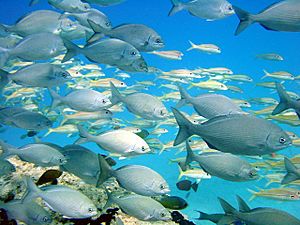Hawaiian chub facts for kids
The Hawaiian chub (Kyphosus hawaiiensis), also known as the bicolor chub, is a special type of ray-finned fish that lives in the ocean. It belongs to the sea chub family and is found only in the waters around Hawaii.
Quick facts for kids Hawaiian chub |
|
|---|---|
 |
|
| Northwest Hawaiian Islands with goatfish | |
| Scientific classification |
Contents
What Does the Hawaiian Chub Look Like?
The Hawaiian chub has an oval body that is quite deep and flat from side to side. Its mouth is at the front and points slightly downwards. The front part of its upper jaw is a bit blunt.
Its body is partly covered in small, rough scales. The dorsal fin (on its back) is one long fin. The front part has 11 stiff spines, and the back part has 12 soft rays. The spiny part is longer, but the soft part is taller.
The anal fin (on its belly, near the tail) has 3 spines and 11 soft rays. The third spine is the longest. The caudal fin (its tail fin) has a slight notch in the middle.
This fish is usually bluish-grey. However, it can change the color of its back half to be darker, creating a clear two-color pattern. Sometimes, its whole body can be dark with a lighter band in the middle. It often has a white stripe just below its eye. The Hawaiian chub can grow up to about 41 centimeters (16 inches) long.
Where Does the Hawaiian Chub Live?
The Hawaiian chub is found all over the Hawaiian Islands. It might also live in the Line Islands, which are a group of islands in the central Pacific Ocean.
Habitat and Daily Life
Hawaiian chubs usually live in small groups. You can find them in the "surge zone," which is the area where waves crash at the top of coral reefs. They also live where the reef drops off into deeper water.
These fish seem to stay in the same places for many years. This suggests they are territorial, meaning they defend a specific area as their home. They sometimes swim with schools of another fish called Kyphosus cinerascens.
The Hawaiian chub eats by grazing on algae. It scrapes off the algal turf that grows on rocks and between corals.
Discovery of the Hawaiian Chub
The Hawaiian chub was officially described as a new species in 2004 by two scientists, Keiichi Sakai and Tetsuji Nakabo.
Before this, people thought that another type of chub, Kyphosus bigibbus, lived in Hawaii. But scientists later found that the fish in Hawaii was actually different from K. bigibbus found elsewhere. This showed that K. bigibbus did not live in Hawaii, and the Hawaiian fish was its own unique species, K. hawaiiensis.

